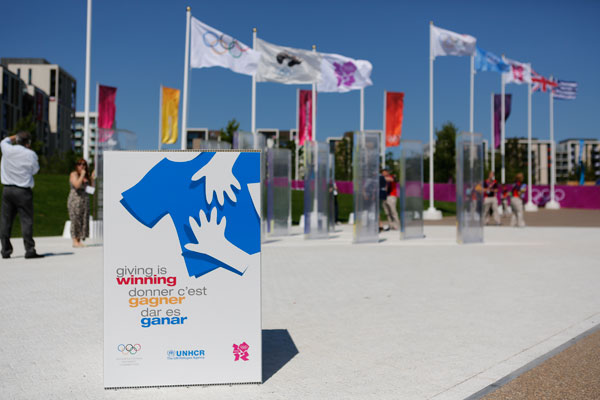The delegation visited the accommodation for the athletes as well as the dining hall and medical facilities before assembling at the Olympic Truce Wall, which has been a fixture in the Olympic Villages since Sydney 2000.
Olympic tradition
The tradition of the Olympic Truce, or ?Ekecheiria”, dates back to the 9th century BC in Ancient Greece as a period during which war and conflict were halted to allow for safe travel to and from the ancient Olympic Games. Today, the Olympic Truce represents the IOC’s aim to inspire peace through sport.
During the unveiling at the Village Plaza, President Rogge also paid tribute to the 11 Israeli team members who were killed during the Munich 1972 Games. ?The 11 victims of the Munich tragedy … came to Munich in the spirit of peace and solidarity. We owe it to them to keep that spirit alive and to remember them,? President Rogge said. ?As the events of 40 years ago remind us, sport is not immune from, and cannot cure, all the ills of the world. But sport can help bridge differences and bring people together. We can see proof of that at these Games.? Read the full text here.
Approximately 10,500 athletes from 204 countries are in London to compete at the Games.
Peace signs
As at past Games, athletes and officials in the village are invited to show their support for the Truce by signing the wall. After the Games, the British Olympic Association will showcase the Wall at the British Olympic Museum in the Olympic Park.
As part of the commemoration of the Olympic Truce, it is traditional for the host country to present a resolution to the United Nations (UN) calling for a truce during the Olympic Games. For the first time, all 193 UN member states united to co-sponsor the Olympic Truce Resolution for the 2012 Games. Through this document, the UN invites its member States to observe and promote peace before, during and after the Games in order to protect the interests of athletes and sport in general.
For information on London?s Truce initiatives, which includes the distribution of educational material to 24,000 schools across the UK and the creation of 400 films about the Truce made by young people, click here.
Giving is Winning

Together with London Organising Committee Chairman Sebastian Coe and outgoing Athletes? Commission Chairman Frank Fredericks, the IOC President also kicked off the IOC?s global solidarity campaign, Giving is Winning, for the 2012 Games that aims to promote sports activities in refugee camps. At every edition of the Olympic Summer Games, the IOC partners with the UN High Commissioner for Refugees and the local organising committee, in this case London 2012, to collect sports clothing and distribute it to thousands of people who have been displaced by violence, famine and other catastrophes.
Thanks to the generosity of the Olympians, National Olympic Committees (NOCs), International Federations (IFs), and other partners of the Olympic Movement, the 2012 edition of the Giving is Winning campaign is expected to break all previous records by collecting more than 100,000 items of clothing for the beneficiary countries of Bangladesh, Ethiopia, and South Sudan.
During the ceremony, President Rogge took the opportunity to thank representatives from the NOCs of Great Britain, Chinese Taipei and Qatar, all of which have already donated large numbers of items.
Donation receptacles are located at the welcome desks of 11 resident centres within the Olympic Village. Additional drop-off points for IOC members and others have been set up at the Hilton Park Lane and IOC logistics desks. Athletes will receive donation bags with an explanatory leaflet and all parties will be regularly reminded about the campaign to encourage donations throughout the Games.

